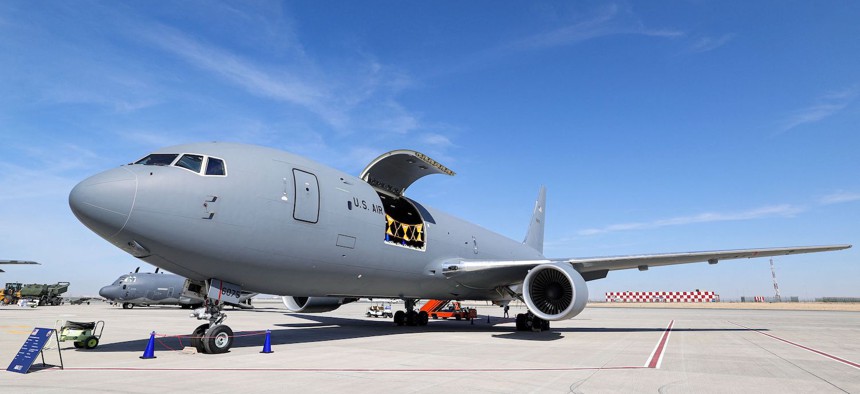
A Boeing KC-46 Pegasus on the tarmac during the 2023 Dubai Airshow. GIUSEPPE CACACE / AFP via Getty Images
Defense Business Brief: L3Harris divesting commercial aviation business; Boeing 'comfortable’ with KC-46 fixes; RNDF preview; and more.
L3 Harris Technologies is selling its commercial aviation business to private equity firm TJC for $800 million as it retools the company to better focus on national security and technology.
Under the terms of the deal, TJC will pay $700 million up front and another $100 million “based on the achievement of certain 2023 and 2024 financial performance targets,” the company said. The deal, which still must go through the regulatory approval process, is expected to close in the first half of 2024.
L3Harris’ Commercial Aviation Solutions provides pilot training, flight data analytics, avionics and other products and services. It employs about 1,450 people.
“Today’s announcement is consistent with our multi-year strategy to optimize our national security, technology-focused portfolio,” L3Harris Chairman and CEO Christopher Kubasik said in a statement. “Aligned with our capital allocation priorities, we plan to use the proceeds from this transaction to repay debt, which will accelerate our timeline to reach our debt leverage objective.”
L3Harris concluded its high-profile acquisition of Aerojet Rocketdyne this summer. Here’s some more about Monday’s divestiture of the company’s commercial aviation business from my Washington Technology colleague Ross Wilkers.
Welcome
You’ve reached the Defense Business Brief by Marcus Weisgerber. A very special thanks to Audrey Decker and Lauren Williams for writing the newsletter while I was on parental leave. I’m incredibly grateful! Send along your tips, and feedback to mweisgerber@defenseone.com or @MarcusReports. Check out the Defense Business Brief archive here, and tell your friends to subscribe!
Speaking of Audrey, she sends this dispatch: Aboard a U.S. Air Force KC-46 on the tarmac of the Dubai Air Show, Boeing said it’s “pretty comfortable” with its plan to fix a myriad of problems still hurting the tanker.
“The airplane itself generally has [category one deficiencies], but when you look at it from a numbers standpoint, the numbers are really not that drastic from a CAT 1 standpoint,” said Sean Martin, a Boeing business development manager.
The program has six deficiencies (all of which the Pentagon labels as “category one,” meaning they could cause loss or damage to the aircraft or even death). Two of the program’s six deficiencies involve the plane’s Remote Vision System, which allows the boom operator to see the boom and the aircraft being refueled through a video feed.
Still, Martin seemed confident that the company wouldn’t have to take more losses on the program—which already top $7 billion—to fix the remaining problems.
“We’ve already projected the cost and we’re driving towards solutions, so we don’t have anything that we’ve just found out about, and the good part of that is we know as we look to recap the next aircraft, all those fixes will be in place before we even start talking about the next airplane,” he said.
Boeing will likely be up against Airbus in a competition to provide the Air Force with its next tranche of tankers, since Lockheed Martin dropped out of its partnership with Airbus to build tankers for the service. But the service has not decided on its acquisition strategy for the next buy, and it’s unclear whether the Air Force will even accept a foreign offer for the competition.
Asked about that competition, Martin said: “We’re building 179 of them, we’ll be supporting them through 2040 at the minimum. We’d like to think that we are a great platform that’s out there doing the mission every day for the Air Force, and we’d love the opportunity to continue to do that…but the DOD and Air Force will make that decision, not Boeing.”
Boeing was showing off its tanker at the Dubai Air Show in part to market the plane to Middle East countries.
“We are seeing a very increased desire for the capability in this region of the world,” Martin said. “The capability is the right size, the right fit for this region.”
But before Boeing could sell new tankers to Mideast countries, it would likely compete against Airbus’ A330 Multi Role Tanker Transport, or MRTT, which Airbus will offer for the future USAF competition.
Tanker deliveries have been paused multiple times this year because of the fuel tank problems and red-tape issues with the Defense Contract Management Agency. However, Martin said Boeing is “back on track” after the pauses and is “driving towards” its goal to deliver 15 tankers to the Air Force by the end of the year.
Boeing has delivered 78 KC-46 aircraft to date: 76 for the USAF and two for the Japan Air Self-Defense Force.
“Boeing works to deliver KC-46A aircraft at a pace that meets the needs of the U.S. Air Force and global customers. There are now more KC-46s in operation globally than any other tanker except the Boeing-built KC-135,” a company spokesperson said.
Boeing’s commercial side had a fantastic week at the air show—raking in three times the number of orders its French rival Airbus had.
ICYMI: Here are more of Audrey’s stories from the Dubai Air Show.
The 10th annual Reagan National Defense Forum is Saturday at the Ronald Reagan Presidential Library in Simi Valley, California. This year’s lineup, as expected, includes many top national security leaders, including Joint Chiefs Chairman Gen. CQ Brown. By my latest count, panelists include six general/flag officers, five senators, seven members of Congress, and eight senior industry executives. Commerce Secretary Gina Raimondo is also among the headliners. The agenda, to date, is here.




